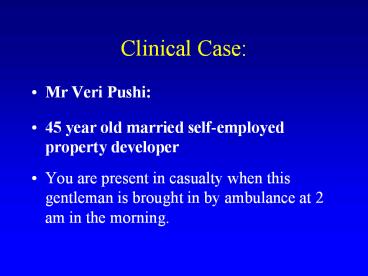Clinical Case: - PowerPoint PPT Presentation
1 / 13
Title:
Clinical Case:
Description:
Title: Clinical Case: Author: RW Last modified by: Jordi M. Morell Created Date: 5/4/2000 1:05:31 AM Document presentation format: On-screen Show Other titles – PowerPoint PPT presentation
Number of Views:116
Avg rating:3.0/5.0
Title: Clinical Case:
1
Clinical Case
- Mr Veri Pushi
- 45 year old married self-employed property
developer - You are present in casualty when this gentleman
is brought in by ambulance at 2 am in the
morning.
2
Clinical Case (2)
- You obtain a quick history from the ambulance
officers, and then from his wife (who arrives
shortly afterwards by car). - His wife had found him collapsed in the toilet,
confused and very pale. - He had been complaining of abdominal discomfort
just prior to the collapse, had vomited up some
altered blood and passed some blackish-red
diarrhoea.
3
Clinical Case (3)
- He had been celebrating the evening before with
business associates after concluding the sale of
one of his new retirement home developments. - A considerable amount of alcohol had been drunk
by the gentleman that evening and he had felt
rough when he arrived home 2 hours previously. - His usual alcohol consumption is around 40-50
units of alcohol per week he has been drinking
at this level for the last 25 years.
4
Questions
- What is likely to have occurred with this
gentleman? - What is the differential diagnosis?
- What are your management priorities?
5
Differential Diagnosis
- Bleeding peptic ulcer
- Gastric / duodenal
- Bleeding oesophageal varices
- Mallory-Weiss syndrome (Oesophageal Tear)
- Haemorrhagic alcoholic gastritis
- Gastric neoplasm eroded bleeding vessel.
6
Management Priorities
- Good venous access.
- Quick assessment of bleed severity.
- Adequate blood samples
- Resuscitation of hypovolaemia and hypotension.
- Assessment of rebleeding risk
- Elderly / hypotensive on admission
- Hb lt 8 or HM on admission
7
Important features to elicit from History
Examination
- Features of hypovolaemia pale, sweaty, pulse
rate, BP. - Previous ulcer disease, GI bleeds
- Concomitant medical conditions.
- Anticoagulation therapy.
- Previous or current liver disease, or risk
factors for its development (alcohol, parenteral
blood products, IV drug abuse etc). - Stigmata of chronic liver disease.
- History suggestive of Mallory-Weiss tear?
8
Investigations
- Laboratory
- FBC
- Group save / Xmatch (see below)
- Clotting profile If on anticoagulants, liver
disease, platelets abnormal, multiple
transfusions - UEs, LFTs
- CXR
- When clinically indicated
- Cardiorespiratory disease / partial gastric
volvulus - ECC
- when clinically indicated.
9
His vital signs on admission were
- BP 90 /50 mm Hg lying unrecordable sitting.
- Pulse 130/min sinus tachycardia
- Respiratory rate 25/min
- Temperature 37.1 C
- JVP not detectable.
10
Patient stabilisation
- Large bore cannulas inserted blood taken.
- Resuscitation with volume expanders until blood
is available Haemaccel / Gelofusin - Packed red cells used in conjunction.
- If hypotensive on admission obtain surgical
opinion. - Arrange endoscopy urgency depending on severity
of bleed and local logistics.
11
Blood cross-match
- 1 unit of blood for every 1g/dl that admission Hb
below 10g/dL. - PLUS
- 4 units if patient is shocked on admission.
- PLUS
- 2 units in reserve for a rebleed.
12
Monitoring management
- BP Pulse stabilised with resuscitation.
- Looking for rebleeding signs
- Fresh haematemesis / malaena in stabilised pt
- Fall in BP rise in pulse in stabilised pt.
- Fall in Hb of gt 2g/dl in 24 hours
13
Unable to stabilise patient
- Seek senior advice.
- Consider the need for repeat endoscopy
- Consider surgical intervention
- Continued bleeding esp spurting vessel.
- Rebleeding in hospital
- 1 rebleed if gt 60 years 2 rebleeds if lt 60 years
- High transfusion requirement
- Age gt 50 years 4 units
- Age lt 50 years 6 units































